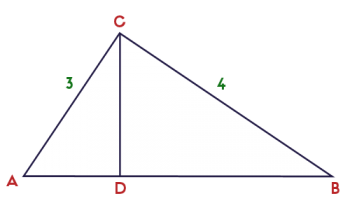Ask Professor Puzzler
Do you have a question you would like to ask Professor Puzzler? Click here to ask your question!
What is the "altitude to the hypotenuse," and how do I find its length, if I know the lengths of two legs?
To answer this question, consider the diagram below. I show a triangle with angles A, B, and C, and right angle at C. The segment CD is the altitude to the hypotenuse. An altitude is a line segment that is perpendicular to a side, and passes through the opposite vertex. Thus, the altitude to the hypotenuse is perpendicular to the hypotenuse, and passes through the point C.

For this example, I gave the legs lengths 3 and 4. I did this so it would work out simply: the hypotenuse is 5 (because 32 + 42 = 52).
The question is, how do we find the length of CD? To figure this out, it is helpful to notice that all three triangles are similar.
ΔABC ~ ΔACD ~ ΔCBD
From this, we know that the ratio of the longer leg to the hypotenuse is the same for each triangle.
In the largest triangle, that ratio is 4/5. In the smallest triangle, that ratio is CD/3.
Thus, 4/5 = CD/3, which leads to CD = 12/5.


